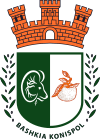Konispol
|
Konispol Konispoli |
||

|
||
|
Coordinates: 39 ° 40 ′ N , 20 ° 11 ′ E |
||
| Basic data | ||
|---|---|---|
| Qark : | Vlora | |
| Municipality : | Konispol | |
| Height : | 400 m above sea level A. | |
| Area : | 221.88 km² | |
| Bashkia residents : | 8245 (2011) | |
| Population density (Bashkia): | 37 inhabitants / km² | |
| Telephone code : | (+355) 891 | |
| Postal code : | 9705 | |
| Politics and administration (as of 2019 ) | ||
| Mayor : | Shuaip Beqiri ( PS ) | |
| Website : | ||
 View from the plain and the road to the Qafa Boti border crossing to the city (2015) |
||
Konispol ( Albanian also Konispoli , Greek Κόνισπολ, Kónispol ) is a small town belonging to the southern Albanian Qark Vlora . It is located high above the coastal plain on a mountain slope at almost 400 m above sea level. A. , around 30 kilometers south of Saranda . The village, visible from afar, is the southernmost place in Albania ; The border with Greece runs directly behind the city . To the north it is about ten kilometers to the Butrint lagoon . The Greek neighboring town of Sagiada is three kilometers away. In 2005, the Qafa Boti border crossing was opened between the two places . Since then, the road to Finiq (SH 97) has also been expanded.
Geography and population
Konispol is enthroned on a ridge around 300 meters above the plain. The center of the village is on the ridge. From there, parts of the village continue up a mountain to the east, others are on the northern slope of the ridge below the center. To the south, the ridge falls steeply into a small valley that separates the town from the Mali i Nartës mountain ( 854 m above sea level ) on the border . Similarly high or even higher mountains rise in the east and north. The national road SH 97 , which leads from the border crossing Qafa Boti to Saranda, runs in the plain . An approximately three kilometer long connecting road leads from the national road to the town center.
Konispol has 2123 inhabitants (2011). Some of them speak Greek as their mother tongue, the majority speak the çamian dialect of Albanian. Many Çamen from Greece settled there, at least temporarily, after the expulsion. Most of the city's employable citizens spend much of the year in Greece, working as seasonal workers in agriculture, construction and tourism. There is little agriculture in the village itself. Some of the inhabitants live from border trade.
Konispol has an Orthodox church, a mosque and a primary and secondary school, some of which are taught in Greek. In contrast to the villages in the surrounding area with many Orthodox and Greek residents, Konispol has a Muslim and Albanian majority. There are still a few large houses in the city that were built in the 18th and 19th centuries in the traditional style of the Epirus region . They belonged to Beys , who once ruled the region.
Significant archaeological finds from all epochs of human history have been made in the vicinity of the village in recent decades . Of particular note are the paleolithic artifacts discovered in the nearby Shpella e Kërçmoit cave .
Since 2015 the two neighboring communities Xarra (4263 inhabitants) and Markat (1859 inhabitants) belong to the Bashkia Konispol . Since the incorporation, Konispol has 8245 inhabitants (as of 2011).
Demographics
In 2011 over 87% of the population declared themselves to be Muslim (including a small Bektashi minority), 4% declared themselves to be Catholics and Orthodox, and 9% gave no answer.
Personalities
- Teme Sejko (1922–1961), Admiral
literature
- Mehmet Kabo: Arsimimi ne Sarandë, Delvinë e Konispol 1920–1944 , Tirana 2004
- M. Korkuti, Halil Shabani: Germimet Arkeologjike të Vitit 1989. Konispol (Sarandë) , in: Iliria 19 (1989), pp. 260-262
- Georgia Kretsi: Persecution and Memory in Albania - An Analysis of Post-Socialist Remembrance Strategies , Harrassowitz Verlag, Wiesbaden 2007, ISBN 978-3-447-05544-4
- KM Petruso et al .: Radiocarbon and archaeomagnetic dates from Konispol Cave, Albania , in: Antiquity 68 (1994), pp. 335-339
Web links
- Official website of the Bashkia (Albanian)
- Konispol Cave, Albania. A Preliminary Report on Excavations and Related Studies, 1992–1994. Printed in: Iliria 26 (1996), pp. 183-224
Individual evidence
- ↑ a b Ines Nurja: Censusi i popullsisë dhe banesave / Population and Housing Census - Vlorë 2011 . Results Kryesore / Main Results. Ed .: INSTAT . Pjesa / Part 1. Adel Print, Tirana 2013 ( instat.gov.al [PDF; accessed April 14, 2019]).
- ^ Karl M. Petruso, Brooks B. Ellwood, Francis B. Harrold, Muzafer Korkuti: Radiocarbon and archaeomagnetic dates from Konispol Cave, Albania , in: Antiquity 68 (1994) 335-339.
- ^ Religious composition of Albania 2011. Retrieved May 14, 2020 .
